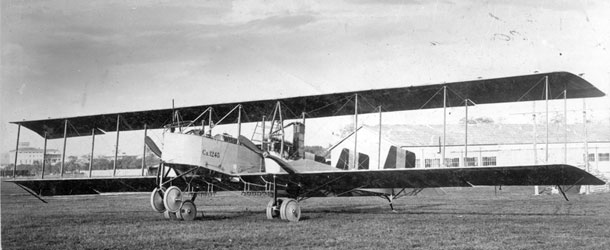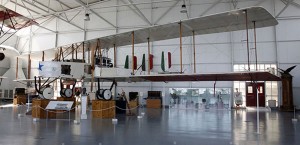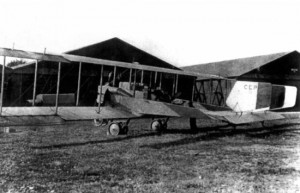The giant bombers flying and fighting during WW1 will soon become a part of the Wings of Glory game. Four special packs featuring the bombers Caproni Ca.3 e Gotha G.V, each in two different versions, will release in early 2012. Waiting for their arrival, let’s learn something more about these huge aircrafts. This first preview presents the Italian bomber Caproni Ca.3 and the two models appearing in these special packs.
A three-engine biplane bomber with over 22 meters of wingspan, of wood and fabric construction, the Caproni Ca.3 is considered the most successful Allied bomber of World War I, taking part in many outstanding raids. Developed from the earlier Ca.1 and Ca.2, it was the definitive version of this series of advanced concept bombers. In the WW1, Italy was one of the leaders in heavy bomber design, and the Caproni Ca.3 was also used by British, French and American squadrons.
The Ca.1, designed in 1913 by Gianni Caproni, was powered by three engines, all contained in a central crew nacelle. It was an aircraft of extraordinary dimensions for that time and equipped with three Fiat A10 engines, each with 100 hp power, and it was employed with great effectiveness during the first two years of WW1. The Italian military authorities then asked for improvements to increase its performances. A limited series, called Ca.2, was then produced with a power plant of 150 hp.
The new series, Ca.3, used the same airframe and landing gear as its predecessors, with even more powerful engines (three Isotta Fraschini 150 hp engines), improved performance and increased bomb capacity. The normal bomb load was 200kg, suspended under the hull, and defensive 7.7mm machine-guns - one in a front ring mounting and one (or more - two or sometimes even three) in an upper ring mounting. The crew included pilot, co-pilot, front gunner and rear gunner.
In February 1917, 150 Ca.3 were committed, and the number was increased to 250 on June, all delivered that year. Further 20 units were ordered on November. The new bombers progressively replaced the previous units. The first Ca.3 were assigned to the IV Gruppo, based at S.Pelagio, in March 1917, but the first mass operations started only three months later. The bombers were also sent to bomber groups at Padova, Ghedi, Campoformido, Aviano and Verona.
The Ca.3 were used mostly in bombing assaults above Austro-Hungary, hitting naval bases, railway junctions and troop concentrations. Outstanding actions involving the Ca.3 are the incursions over Assling, in Austria, and Chiapovano, in Slovenia.
Caproni Ca.3s were also used by British squadrons. Original and license-built ones were used by France (original Caproni were used in French CAP squadrons and license-built examples in CEP squadrons). They were also used by the American Expeditionary Force. The Ca.3 operated until the end of the war, and some of these aircrafts saw action also in the post-war era, in the first Mussolini’s assaults to North Africa.
One of the Ca.3s featured in the special packs of Wings of Glory WW1 was the aircraft piloted by Lieutenant Casimiro Buttini. This white biplane with the insignia “Falco!...” is one of the survivors of the war and can be seen today, restored, at the Museo Storico dell’Aeronautica Militare (Military Aeronautic Historical Museum), near Rome.
Buttini, from the 3rd Bomber Squadron, earned a Gold Medal “al Valor Militare” for an action performed using a Ca.3 like this. On September 9th, 1917, he took part in a bombing assault over Ternova (Trieste, frontier with Slovenia). The motivation for the medal describes an heroic scene.
Despite the intense and well-aimed fire from enemy’s artillery, Buttini lingered on positions to beat, without caring about the danger, to launch his bombs with precision. The aircraft was hit by firing blasts always more precise, and Buttini saw his co-pilot killed by a grenade that decapitated him. Buttini had an arm injured and his face was covered by his companion’s blood, and he had to face serious problems to control the aircraft, which was damaged in several parts. His aircraft didn’t respond to the commands, but Buttini kept and instilled in the crew a heroic calm with his strenuous and resolute behavior. After remarkable efforts, he was able to set straight the course of the plane. The Caproni was losing altitude and descending over the enemies’ lines, through furious musketry, artillery and machine gun fire, but he was successful in bringing back to Italy his surviving companions and the dead co-pilot.
The aircraft shown at the historical museum was purchased by Buttini at the end of his service in the Air Force, and was stored in a farm house in Piemonte, Italy. In 1959, the Aeronautica Military bought back the biplane.
The other bomber featured in Wings of Glory is the C.E.P. 115 – a Caproni Esnault Pelterie, produced in France by Robert Esnault Pelterie under license.
The first agreement to supply the Caproni Ca.1 to France was signed in February 1915, but the sale was delayed due to questions regarding the engine choice and the opposition of Italian authorities, not inclined to transfer the technology to other nations. Gianni Caproni studied some variants with French motors, and then the order was granted to Robert Esnault Pelterie – and later also to the S.A.I.B., a subsidiary of Bessoneau.
The first unit produced by R.E.P. was approved on August 12th, 1915, and was equipped with two lateral rotary engines Rhone 9C of 80 hp and a center radial engine Salmson-Canton Unnè 9R of 130 hp. This configuration was used for most of the production, about 80 aircrafts in total. In February 1916, these airplanes formed the Escadrille CEP 115, part of the French bomber group GB.1. The squadron was deployed at Nancy-Malzeville and entered in action on June, 22nd. On August 1917 the CEP 130 was formed, assigned to the GB.2 bomber group. In March 1918, also the CEP 115 became part of this group.
These French bomber groups cooperated with the Italian Ca.3 from XVIII Gruppo, which had been sent to the Western front. They made damaging night raids on targets along the Marne as well as attacking troop concentrations near Amiens.
Information sources: Virtual Aircraft Museum, The Aerodrome, Wikipedia, Museo Storico Aeronautica Militare, Aerei Militari, Regia Aeronautica Italiana.











